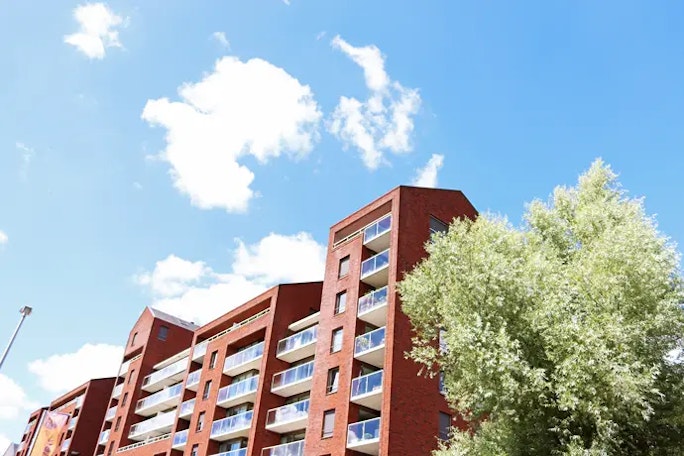Table of contents
Buying a new-build home works a bit differently than buying an existing house. We guide you through the entire purchasing process in 10 steps, so you know what to pay attention to and how to handle things like a new mortgage and double expenses. Good luck!
Step 1: Outline your wishes
Before you start looking for a new-build home, it's useful to outline your wishes. What type of house are you looking for exactly? What is your search area? What are the 'must-have' requirements you have? And what is your maximum budget? This way, you can search more specifically.
Your maximum budget depends on your income, personal savings, and any equity from your current home. If you want to know what budget you can work with, schedule a meeting with a mortgage advisor. They will consider all factors to determine the potential amount for your new-build mortgage.
Step 2: Find the right real estate agent and mortgage advisor
To quickly find a good new-build house and ensure the purchasing process runs smoothly, it's wise to hire a real estate agent and a mortgage advisor.
- A real estate agent has extensive knowledge of the local market and access to exclusive new-build projects. They guide you through the entire purchasing process, from finding homes to reviewing contracts.
- A mortgage advisor helps you find the best financing options. Additionally, they have knowledge of specific regulations and subsidies that may apply to new-builds. This provides peace of mind throughout the entire building and purchasing process.
The search for a good real estate agent can be quite intensive. If you want to compare properly, you need to compare the offers and rates of different agents. If you have to contact various agents yourself, it takes a lot of time. We thought it could be easier. That's why with our service, the roles are reversed for you: you don't take the initiative, the real estate agents do!
Register with us for free and receive various proposals from reliable agents at competitive rates in the coming days. Compare the offers and have a no-obligation conversation. Is there a match? Then you've found your real estate agent! If you wish, you can also request a free mortgage consultation through the real estate agent.
- Free
- Independent
- No obligation
- Fast
Do you have questions about our service? Read how it works or contact us!
Step 3: Search for suitable new-build homes
Now that you know what kind of house you're looking for and you have the right professionals involved, you can start house hunting specifically. Set the right filters on Funda, keep an eye on ads from real estate agents and project developers, and subscribe to their newsletters. They often provide information about new new-build projects. This way, you're among the first to know.
Your real estate agent probably also has a wide network and access to exclusive new-build projects. This gives you access to new-build projects before they hit the open market. This gives you an advantage over other buyers.
Visit a model home
Have you seen an interesting new-build project? Sometimes you can visit to view a model home. A visit gives you a realistic view of the space, finish, and layout of the future house. Whether there are model homes depends on the size of the project, the phase the project is in, and the developer's strategy.
Conduct thorough preliminary research
Conduct thorough preliminary research before registering for a new-build project. Carefully read the sales brochure, inquire about the list of additional and omitted work, and ask about any construction guarantee. Ask all your questions to get a complete picture of the project. A real estate agent can help you ask the right questions and investigate risks.
List of additional and omitted work
New-build projects often have a standard layout. If you want to deviate from this standard, it can have financial consequences. The list of additional and omitted work provides insight into which tasks have been added (additional work) or omitted (omitted work) and the financial impact of these.
Together with the builder, you compile this list before signing the purchase agreement, so you know exactly what changes will take place and what the costs or savings will be.
The list of additional and omitted work provides clarity about the project scope and expectations upon completion, helps prevent delays, and provides a realistic view of the delivery date. It also provides legal certainty for you as a buyer, as the official document obliges the builder to adhere to the agreements.
A real estate agent (and possibly a legal advisor) can assist you in compiling the list of additional and omitted work by advising you on the changes, examining the financial impact, and ensuring everything is clearly and accurately documented.
Construction guarantee
If you want to buy a new-build home, it is wise to do so with a construction guarantee. This guarantee ensures that your home will be completed even if the builder goes bankrupt. Many mortgage providers require such a construction guarantee for obtaining a mortgage.
Step 4: Register for interesting new-build homes
Are you still enthusiastic about the new-build home after the initial research? Then you can register for the project. Registering for a new-build home usually occurs through an online registration form on the developer's or real estate agent's website, where you provide personal information and any preferences for types of housing.
If there are multiple interested parties, a lottery usually follows. The available homes are assigned to interested parties based on a random system or certain criteria such as registration date or urgency. The outcome of the lottery determines whether you are eligible for a specific home and under what conditions you can proceed with the purchase.
Step 5: Sign the purchase agreement (if you are selected)
If you are selected for the new-build project, it's time to sign the 'purchase contract.' With new-builds, you will deal with a 'purchase agreement.' This is an agreement prepared by the builder. By signing it, you authorize the builder to (complete) construct the new-build home.
It's important to read this document carefully before agreeing, as you are committing to a significant obligation. Of course, your real estate agent will also review it with you. It's good to pay attention to the following things:
- The sale price and construction interest
- The costs and payments (including payment terms)
- The list of additional and omitted work
- The construction guarantee
- The construction time
- The delivery conditions
- Penalty clauses and cancellation conditions
- Resolutive and suspensive conditions
A real estate agent can compare the sale price and interest with market values to check if you are getting a fair deal. They can also help you negotiate the best terms and price and assist you in reviewing the documents. The knowledge and experience of the agent ensure that you are well-informed and protected during the purchase.
Step 6: Go through the reflection period
If you are a private buyer, you have a 3-day reflection period after signing the purchase agreement. In many agreements, an even longer period is included, such as a week. During this time, you can still withdraw from the purchase without consequences. If you let the purchase proceed, you are 'bound' to the obligations unless there is a resolutive condition.
Step 7: Arrange the financing of your new-build home
In the initial phase, you probably already had a conversation with a mortgage advisor, so you know what you can (approximately) borrow. Now is the time to finalize the financing. Contact your mortgage advisor to apply for the new-build mortgage. With a new-build mortgage, you finance:
- the land on which your new-build house will be built
- the work the builder has already completed
- the work the builder will still perform (this amount is deposited into a construction deposit, from which the remaining construction terms are paid to the builder)
For new-build projects, you usually have more time to finalize the financing than with regular sales. Typically, you have around 8 weeks, but always check the specific conditions of the purchase agreement.
If you can afford it, it is often possible to finance the costs of construction interest and additional work. However, be cautious: this is not always the most advantageous option, as you will also pay mortgage interest on this extra amount. A mortgage advisor can inform and advise you on this.
Read more about all costs for buying a new-build home
The bridging mortgage
Do you already own a house? Then you'll probably continue to live there as long as your new home is under construction. It may also be that your house is already on the market, but the sale is not yet finalized. To secure the financing for your new-build house, you can take out a bridging mortgage.
This is a temporary loan that helps you bridge the period between purchasing a new home and selling your old home. It ensures that you can already utilize the sales proceeds and any equity from your old home for financing your new house. Once you sell your old home, the loan is repaid in one go.
Read more about the bridging mortgage

Step 8: Temporarily pay double expenses
Because you already incur costs for the new-build home while it is being constructed, most people temporarily face double housing expenses. You have to finance both your current home and your new home at the same time, unless you are 'staying' for free with family or friends.
There are several ways to finance these double expenses:
- Do you have sufficient savings? Then you can use this money to finance the double housing expenses. But be careful: always leave enough money for the rest of the costs of a new-build home.
- Have you built up a lot of equity in your current home? You can already use this money through a bridging mortgage before the house is sold.
- Under certain conditions, it may be possible to refinance your mortgage and borrow extra on your current home to cover the double expenses. This can help bridge the period during which you have double housing expenses.
- Under certain conditions, you may be able to take out a second mortgage for the new-build home. You must have sufficient capacity for both mortgages. You may be entitled to double mortgage interest deduction. Read more about this on our page about a double mortgage.
Step 9: Start selling your current home
As the delivery date approaches, you may choose to put your current home up for sale. This can also be done earlier or later, depending on what feels right for you. On our page about selling a home with new-build you can read more about this.
To sell your current home at the right price and quickly, hiring a real estate agent is crucial. You can often also hire your real estate agent as a sales agent. If you are satisfied with the services of the office, it can be convenient and advantageous to remain with the same party because they are already familiar with your situation and wishes.
Do you need a good real estate agent? You can quickly find one via Mijn Verkoopmakelaar.
- Register for free and without obligation
- Receive proposals from the best agents in the area
- Compare based on costs, performance, and personal click
- Over 3000 people have gone before you
- Competitive rates
- On average 2% higher sales revenue
Enter your postal code and house number and receive multiple proposals in your mailbox in the coming days. Compare the agents and start working together. No time to lose!
Find a sales agent- Free
- Independent
- No obligation
- Fast
Do you have questions about our service? Read how it works or contact us!
Step 10: Sign the transfer of ownership with the notary
In new-builds, the transfer of ownership usually takes place when the house is fully built and ready for delivery. You will then go to the notary, where you sign the deed of transfer. The ownership of the new-build home then officially transfers.
After this transfer of ownership, you become the owner of the plot, plus everything built on it. The transfer of ownership can only take place when nothing is uncertain anymore. The financing must be finalized, and you must have an unassailable permit and a guarantee certificate. This is also the time when your new mortgage takes effect.
Check the delivery
Subsequently, the delivery takes place, during which you inspect the house and can report any defects or deviations. You can inspect everything yourself (together with your real estate agent), but you can also have a special delivery inspection conducted. This inspection is done by a building expert.
If everything is in order, you sign this in a delivery report. This document contains a detailed report of the property's condition at the time of delivery, including any defects, deficiencies, or unfinished work that needs to be addressed by the builder.
The report is signed by both the buyer (you) and the seller (builder or developer) and is used as formal evidence of the property's condition and the agreed-upon work.
Defects? Use the 5% rule
The builder has signed that they will repair any defects. To add extra pressure, the 5% rule has been introduced. This gives you, as a buyer, the legal right to withhold 5% of the contract sum at the notary at the time of delivery. The builder will only receive this amount once they have repaired or resolved the defects on time.
Do you encounter other defects later - when you are already living in the house? You can often still address the builder on this. Contact your real estate agent and get advice on the steps to take.
The key handover
After signing, you receive the key to your new house. Time to pop the champagne!
















